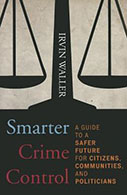Smarter Crime Control: A Guide to a Safer Future for Citizens, Communities, and Politicians

Author: Irvin Waller
Publisher: Lanham, MD: Rowman & Littlefield, 2014. 300p.
Reviewer: Steven Block | September 2014
In “Smarter Crime Control: A Guide to a Safer Future for Citizens, Communities, and Politicians,” criminologist Irvin Waller uses decades of international experience to detail an approach to reduce crime and minimize economic costs in the United States. While the task is daunting, Waller’s credentials and previous publications allow him to summarize his arguments in a manner that is convincing and accessible to many different types of readers.
There is no controversy that the problems that Waller addresses in this book are worthy of serious consideration. It is undeniable that the U.S. spends more money in the criminal justice system than any other country. It is also unarguable that incarceration rates in the U.S. easily surpass that of other developed nations. Yet, for many citizens, politicians, and even some criminologists, these facts are viewed as positives rather than negatives. Waller acknowledges that this sentiment exists and notes that some people believe the well-documented crime decline of the 1990s and 2000s can be attributed to policies allowing America to get tougher on crime. However, the author utilizes an international perspective to argue that crime has declined in other nations outside the U.S. over the same time period, and that further improvements in the U.S. should be expected if the correct path is followed.
The author’s response to the current use of reactive policing, a traditional court system, and an overworked corrections system is illustrated by a clever analogy in the second chapter. In a comparison between approaches toward crime and the oil industry, Waller questions the logic associated with a policy that would dedicate most of our resources toward cleaning up oil spills. Of course, more attention is dedicated toward stopping oil spills from occurring initially. When crime is discussed, however, most people accept that crime is inevitable and allow the allocation of resources to the process of reacting to crime. At that point, the harm has already been done, victims are forever scarred, and options are limited. In short, Waller’s approach supports prevention instead of reaction, while acknowledging that a more efficient criminal justice system is a necessary goal as well.
The book is divided into three parts and 10 chapters. The introductory chapter establishes the framework for the rest of the work. Well-developed charts and tables demonstrate that the U.S. has higher levels of homicide, traffic fatalities, and incarceration than other comparable nations. In most instances, the differences jump off the page. Waller relies on many sources of data to illustrate his points in the opening chapter.
Part I of the book is comprised of three chapters. Chapters 2 through 4 tackle each part of the criminal justice system individually. In these chapters, Waller describes what is known to work, what does not work, and what is promising pending further research. His conclusions are based on empirical research conducted by scholars over the last few decades in most cases. In these chapters, Waller reviews some of the classic pieces of research showing reductions in crime and costs, such as Boston’s Operation Ceasefire, the Kansas City Gun Experiment, New York City’s Community Court, and California’s Proposition 36. Concise explanations are provided to summarize the logic associated with each initiative. Conversely, the main targets of Waller’s criticisms include reactive 911 policing, random policing patrols, court systems focused solely on justice, and lengthy prison sentences. In summary, this section of the book argues for a smaller, smarter criminal justice system at every stage.
In Part II, five chapters are dedicated to demonstrating that proactive prevention is preferable to reaction. To illustrate this point, Waller chooses five specific areas of crime and disorder: youth repeat offending, gun violence, violence against women, road injuries and fatalities, and property crimes. Although the format of the sections is quite different than in Part I, the author again relies upon research-driven arguments to strengthen his case that prevention can and does work. This examination of research arrives at support for several early intervention programs, ignition interlock devices for drunk-driving, and comprehensive community-based firearm initiatives. In several of these chapters, the author posits that the most balanced approach to achieve efficiency includes both effective prevention and smart crime control. The final part (and chapter) of the book brings together Waller’s central ideas.
This book is well suited for undergraduate classes within criminology or criminal justice programs that focus on policy. The language in the book is written in a manner that citizens outside of criminology will benefit as well. There is little jargon and no advanced statistics are presented that would impact a reader’s understanding of the main conclusions. For those in the criminology field, most well-trained criminologists will be familiar with several of the examples of well-documented programs and studies provided in the book, such as problem-oriented policing and drug treatment courts. However, the varied nature of the topics in Chapters 4 through 9 makes it unlikely that even the most seasoned criminologist would be aware of the research relating to early childhood development, domestic violence, and traffic safety. It is these sections, in particular, that draw evidence from a wide array of subtopics.
There are some key areas for further discussion that are beyond the intended scope of this book. Within its title, the text mentions citizens, communities, and politicians. Unfortunately, the final group on this list is a particularly tough population to impact with data-driven ideas. Politicians in the U.S. generally side with reactive crime control policies that appease large segments of the general public. Policies that garner political support include ineffective zero tolerance strategies, more policing above “smart” policing, a greater reliance on mandatory sentencing, and harsh laws toward victimless crimes. While the current book does an excellent job of summarizing the approaches that have proven successful, there is little discussion about how to actually enact this change at local or national levels. In many instances, politicians may know the ideas they promote are not in the long-term interest of their constituents, but the long-term investments do little to further their short-term goals of political popularity and re-election. In other situations, the author’s conclusions would be quickly dismissed by a strong segment of politicians through much of the U.S. For instance, the final recommendation in Chapter 6 states that “legislators should look for ways of reducing the numbers of guns, particularly handguns” (p.160). Most conservative, and even some liberal politicians, would not even engage in this discussion.
Ideally, the impact of this book will not be on politicians directly, but rather on citizens. If the public is more educated about actual research findings related to criminal justice policy, more pressure will be placed on politicians to rely on science above personal ideology.
In summary, the early stages of this book contain a broad discussion about what works relating to policing, the courts, and the corrections system. In that sense, the approach is somewhat reminiscent of classics such as Samuel Walker’s policy-focused books. Waller’s text then shifts to a vivid description of effective prevention strategies for an array of different problems. It is these chapters that contain Waller’s most notable contributions, and give the book a place on the bookshelves of citizens and in the syllabi of college courses.
Steven Block, Assistant Professor, Department of Criminology and Criminal Justice, Central Connecticut State University


